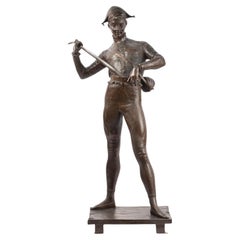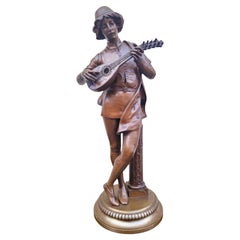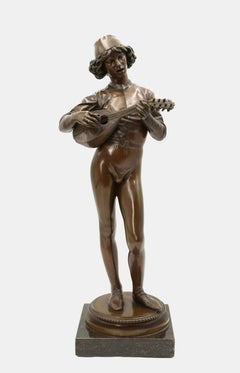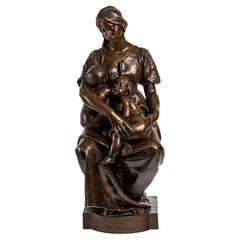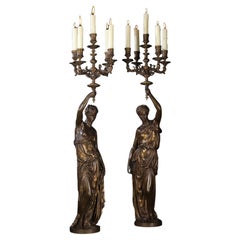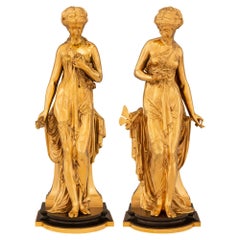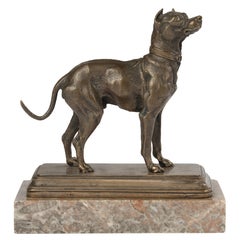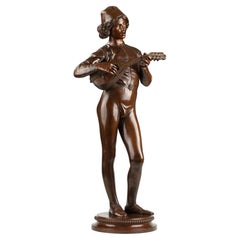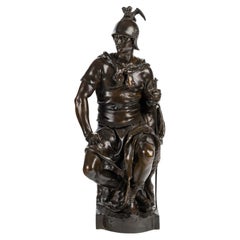Paul Dubois Furniture
to
1
6
5
11
4
2
1
1
1
1
1
A Large Bronze Sculpture of the Harlequin by Paul Dubois, 19th Century.
By Paul Dubois
Located in Saint-Ouen, FR
A large bronze sculpture of the Harlequin by Paul Dubois, 19th century, Napoleon III period.
Bronze sculpture by Paul Dubois, the Harlequin, 19th century, Napoleon III period, bronz...
Category
19th Century French Napoleon III Antique Paul Dubois Furniture
Materials
Bronze
Paul Dubois, The Florentine Singer Of The 15th Century, Signed Bronze, 19th Cent
By Paul Dubois
Located in MARSEILLE, FR
Large double patina bronze representing the Florentine Singer of the 15th century, signed P Dubois Fr
The young and elegant boy, standing, plays and sings, leaning against a column:...
Category
19th Century French Renaissance Antique Paul Dubois Furniture
Materials
Bronze
Florentine singer / - The Renaissance of the Renaissance -
By Paul Dubois
Located in Berlin, DE
Paul Dubois (1829 Nogent-sur-Seine - 1905 Paris), Florentine singer, 1865. Light brown patinated bronze with cast round plinth mounted on a square marble base (3.5 cm high). Total height 53 cm. Bronze dimensions: 49.5 cm (height) x 20 cm (length) x 10 cm (width), weight 5.6 kg. Inscribed on the plinth "P.[aul] DUBOIS", dated "1865", with the foundry's mark "F. BARBEDIENNE FONDEUR" and the signet "REDUCTION MECANIQUE A. COLLAS".
- Patina very occasionally darkened, lute with loss of one tuning peg, otherwise in excellent condition.
- The renaissance of the Renaissance -
The bronze is a precisely executed and masterfully cast contemporary reduction of Paul Dubois 155 cm tall masterpiece "Florentine Singer", which is exhibited in the Musée d'Orsay and for which the artist was awarded the Medal of Honor at the Paris Salon in 1865. The work acted as a beacon, and was followed by a plethora of depictions of juveniles.
Inspired by Donatello and Luca della Robbia, but also by painters such as Piero della Francesca, Benozzo Gozzoli, and Pinturicchio, the "Florentine Singer" is not an epigonal work that pays homage to a vanished era, but a successful attempt to draw vitality from the art of the past and thus give it new life.
The effect of vitality is the core of Italian Renaissance art theory. In order to fulfill itself as art, art had to appear like nature. This naturalism also characterizes the "Florentine Singer". The young man appears to have been taken from life, which is reinforced by the momentary nature of his action. He has just struck a now fading chord. In addition, the natural appearance is enhanced by the detailed shaping of the figurative details, such as the laces with the slightly curved leather of the shoes, the belt buckle, or the ornamentation on the body of the lute. Even the fingernails are clearly defined. Unlike the Renaissance, however, the effect of liveliness here is not based on the "discovery" of nature and the human body, but primarily on the rediscovery of the art of the Quattrocento. The liveliness of the artwork is therefore at the same time a revitalization of this art, so that we can speak of a Renaissance of the Renaissance, just as the Pre-Raphaelites in England at the same time transferred the Quattrocento to contemporary art.
Dubois takes on the most difficult of all subjects, the depiction of singing through silent sculpture. He was preceded in this by Luca della Robbia and Donatello with their pulpits of singers created in the 1430s in the Museo dell'Opera del Duomo in Florence. Compared to these works, the physiognomy of Dubois singer is far less animated, yet he also depicts singing in a convincing manner. He uses the whole body. He takes the ancient contrapposto, which was essential to Renaissance sculpture, and transforms the standing leg-playing posture into a late medieval S-swing, giving the body an elegant beauty and at the same time setting it in melodic motion. In the equally elegant finger position, the music is expressed in a much more literal way with the beating of the lute. Finally, the musicality of the sculpture culminates in the face with the mouth open to sing.
Through the act of singing, which is a great challenge to the artistic will to depict perfect beauty, the gracefulness of the classical face is not diminished, but enhanced. Starting from the face with the singing mouth and the gaze absorbed by the sounds, the inner vitality spreads, giving the bronze sculpture an intense aura, enhanced by the music. Dubois transfers the beauty of the Renaissance to the musical, sublimating the visible sculpture to the invisible of music.
He took up the challenge of transcending the Renaissance with the Renaissance, thus responding to the Querelle des Anciens et des Modernes, which arose at the end of the 17th century around the French Academy and remained virulent into the 19th century, in which antiquity was regarded either as an unattainable ideal or as a standard to be surpassed. With his work, Dubois proved that the Renaissance, which had championed the art of the ancients, could lead to a new renaissance of art.
About the artist
Paul Dubois' great-uncle was the famous French Baroque sculptor Jean-Baptiste Pigalle, in whose footsteps the talented great-nephew followed. When he debuted at the Paris Salon in 1858, he signed his work "Dubois-Pigalle". At his father's request, however, he first studied law before devoting himself to sculpture under the tutelage of François Christophe Armand Toussaint in 1856 and entering the École des Beaux-Arts in 1858. From 1859 to 1863, he lived in Rome and traveled to Naples and Florence. Inspired by Florentine art of the quattrocento, Dubois initiated a school-forming neo-Florentine style that combined the elegantly simple forms of youthful grace with a precise wealth of detail.Two purchases by the French state (“envois de Rome”) were made during his stay in Rome, which brought him recognition in Paris. After his return there, he quickly became an internationally sought-after artist.
Dubois was also active as a creator of monuments. His most famous work is the equestrian statue of Joan of Arc (1896) on the forecourt of Reims Cathedral. He was also a sought-after portraitist who produced around 50 busts and - Dubois was also a passionate painter - around 100 portraits in oil.
From 1873 to 1878 he was curator of the Museum du Luxembourg, in 1876 he became a member of the Institut de France and from 1878 to 1905 he was director of the École des Beaux-Arts.
In 1865, Dubois was awarded the Paris Salon Medal of Honor for his “Florentine Singer”. In 1867 he became Chevalier, in 1874 Officier, in 1886 Commandeur of the Légion d'honneur, which awarded Dubois the Grande Croix in 1896.
Selected Bibliography
Stole, Elmar: Paul Dubois. In: Saur. Allgemeines Künstlerlexikon, vol. 30, Munich - Leipzig 2001, pp. 677-678.
GERMAN VERSION
Paul Dubois (1829 Nogent-sur-Seine - 1905 Paris), Florentinischer Sänger, 1865. Hellbraun patinierte Bronze mit gegossener runder Plinthe auf quadratischem Marmorsockel montiert (3,5 cm Höhe). Gesamthöhe 53 cm. Maße der Bronze: 49,5 cm (Höhe) x 20 cm (Länge) x 10 cm (Breite), Gewicht 5,6 kg. Auf der Plinthe mit „P.[aul] DUBOIS“ bezeichnet, auf „1865“ datiert, mit dem Gießereistempel „F. BARBEDIENNE FONDEUR“ und dem Signet „REDUCTION MECANIQUE A. COLLAS“ versehen.
- Patina sehr vereinzelt nachgedunkelt, Laute mit Verlust eines Stimmwirbels, ansonsten ausgezeichnet erhalten.
- Die Renaissance...
Category
1860s Realist Paul Dubois Furniture
Materials
Bronze
$4,255 Sale Price
20% Off
"The Mother", Brown Patinated Bronze, Sculpture by Paul Dubois
By Paul Dubois
Located in Saint-Ouen, FR
"The mother", sculpture by Paul Dubois in brown patinated bronze, foundry Barbedienne (1829 - 1905)
Measures: H: 66 cm, W: 24 cm, D: 32 cm.
Category
19th Century French Napoleon III Antique Paul Dubois Furniture
Materials
Bronze
Pair of Gilt and Patinated Bronze Candelabra by Ferdinand Barbedienne
By Paul Dubois, Ferdinand Barbedienne
Located in Brighton, West Sussex
A Pair of Gilt and Patinated Bronze Figural Five-Light Candelabra Cast by Barbedienne after the Models by Alexandre Falguière and Paul Dubois.
Signed ‘FALGUIERE’ and ‘P. DUBOIS’ ...
Category
19th Century French Antique Paul Dubois Furniture
Materials
Bronze
True Pair Of French 19th Century Neo-Classical St. Ormolu And Bronze Statues
By Paul Dubois
Located in West Palm Beach, FL
An elegant and high quality true pair of French 19th century Neo-Classical st. Ormolu and patinated Bronze statues, signed Paul Dubois. Each beautiful maiden is raised by an Ormolu a...
Category
19th Century French Neoclassical Antique Paul Dubois Furniture
Materials
Bronze, Ormolu
Continental School Bronze Figure of a Boy Fishing
By Paul Dubois
Located in Atlanta, GA
Late 19th-20th century, Continental school, French; cast bronze sculpture; depicting a well modeled figure of a young boy, draped in a net, his arm resting on an anchor, holding a fi...
Category
19th Century French Antique Paul Dubois Furniture
Materials
Bronze
Important Pair of Monumental Parcel-Gilt and Patinated Bronze Figural Torchère
By Jean Alexandre Joseph Falguière 1, Paul Dubois, Ferdinand Barbedienne
Located in New York, NY
Mounted as lamps and cast by Ferdinand Barbedienne after models by Alexandre Falguiere and Paul Dubois. Both statues are signed on the bases.
These fine torchères are reductions ...
Category
Late 19th Century French Renaissance Antique Paul Dubois Furniture
Materials
Bronze
"Florentine Singer" Bronze Sculpture by P. Dubois and F. Barbedienne, Circa 1880
By Ferdinand Barbedienne, Paul Dubois
Located in PARIS, FR
Signed P. Dubois 1865 and F. Barbedienne fondeur
Stamped with réduction mécanique Collas
A patinated bronze « Florentine Singer » sculpture, inspir...
Category
1880s French Antique Paul Dubois Furniture
Materials
Bronze
"The Mother" Bronze Sculpture by P. Dubois
By Paul Dubois
Located in Los Angeles, CA
"The Mother" is a remarkable patinated bronze sculpture created by the renowned French artist, Paul Dubois. This masterpiece captures the essence of maternal love, depicting a mother...
Category
1880s French Antique Paul Dubois Furniture
Materials
Bronze
Late 19th Century Bronze Sculpture Entitled "Marquerite" Signed P. Dubois
By Paul Dubois
Located in Long Island City, NY
A wonderful late 19th century bronze sculpture entitled "Marquerite"
Signed P. Dubois
The bronze depicting a beautiful woman playing the harp.
Paul Dubois was born on the 18...
Category
Late 19th Century French Belle Époque Antique Paul Dubois Furniture
Materials
Bronze
Vase in ceramic signed .Dubois
By Paul Dubois
Located in Rio De Janeiro, RJ
Vase in ceramic signed P Dubois and dated 67 in perfect conditions
Category
1960s French International Style Vintage Paul Dubois Furniture
Materials
Ceramic
Related Items
19th Century Bronze Sculpture of a Terrier Dog - made by Alfred Dubucand
By Alfred Dubucand
Located in Casteren, Noord-Brabant
A beautiful small bronze sculpture by the French Animalier / artist Alfred Dubucand.
It is a terrier dog, very refined bronze with beautiful details.
Alfred Dubucand (1828-1894) is a...
Category
Mid-19th Century French Napoleon III Antique Paul Dubois Furniture
Materials
Marble, Bronze
$945
H 5.12 in W 4.73 in D 2.76 in
"Florentine Singer" Bronze Sculpture by P. Dubois and F. Barbedienne, Circa 1880
By Ferdinand Barbedienne, Paul Dubois
Located in PARIS, FR
Signed P. Dubois 1865 and F. Barbedienne fondeur
Stamped with réduction mécanique Collas
A patinated bronze « Florentine Singer » sculpture, inspir...
Category
1880s French Antique Paul Dubois Furniture
Materials
Bronze
$10,048
H 36.62 in W 15.36 in D 10.63 in
19th Century Bronze Sculpture "The Letter"
Located in Rochester, NY
Antique bronze sculpture of man reading a letter or proclamation. Marble base, 19th century. Unsigned.
Category
19th Century European Antique Paul Dubois Furniture
Materials
Bronze
Large 19th Century Bronze Sculpture of Borghese Gladiator
Located in New York, NY
Borghese Gladiator, after the antique
large patinated bronze sculpture
Italy, 19th Century
H 20 in. (50.8 cm)
Original marble sculpture was found in the early 1600's in the Anzio so...
Category
19th Century European Antique Paul Dubois Furniture
Materials
Bronze
19th Century Pair of Large (2) Bronze Sculptures Empire
Located in Berlin, DE
Pair of (2) monumental Empire bronze sculptures, Paris.
Gilded bronze sculptures standing on multi-tiered rectangular bases.
Very elegant and decorative, it is a guaranteed eye-ca...
Category
19th Century French Antique Paul Dubois Furniture
Materials
Bronze
Pair of French Charles X Patinated Bronze and Gilt Figurative Candelabras
Located in Dallas, TX
A fine pair of figurative candelabras in the form of a patinated bronze cherub running with a gilt torchiere in each hand. The cherubs stand on a...
Category
Early 18th Century French Charles X Antique Paul Dubois Furniture
Materials
Marble, Bronze
$2,600 / set
H 16.5 in W 7 in D 3.25 in
A Thai Bronze, Buddha Fragment, 15th Century
Located in PARIS, FR
A Thai bronze, Buddha fragment, 15th century.
Arm, hand and leg fragment, mounted on a plexiglas stand from 70s.
Overall: 17,2 cm.
Category
15th Century and Earlier Antique Paul Dubois Furniture
Materials
Bronze
Pair of Regency Gilt and Patinated Bronze Atlas Figural Candelabra
By Messenger & Phipson
Located in Essex, MA
Pair of Regency or William IV figural candelabra in form of Atlas and a globe. Six arms issuing from top. Patinated bronze, gilded bronze and bronze. A truly rare from. Attributed to...
Category
Early 19th Century English Neoclassical Antique Paul Dubois Furniture
Materials
Bronze
$16,500 / set
H 27 in W 13 in D 12 in
19th Century Bronze of the Borghese Gladiator
Located in London, GB
Nineteenth century bronze of the Borghese Gladiator, Italian or French, mounted on a richly figured Convent Sienna marble base.
Category
19th Century Italian Classical Roman Antique Paul Dubois Furniture
Materials
Siena Marble, Bronze
19th Century French Bronze Sculpture
Located in Atlanta, GA
This exquisite 19th-century French bronze sculpture captures the essence of rural life through the figure of a young peasant boy. The boy is depicted with a charming, rustic appeal,...
Category
19th Century Italian Antique Paul Dubois Furniture
Materials
Metal, Bronze
Patinated Bronze Sculpture by Paolo Scoleri
By Paolo Soleri
Located in Winnetka, IL
This cast patinated sculpture can be hung by the ring at the top or stand upright on a flat surface. It also bears the foundry mark of Scoleri.
Category
Mid-20th Century American Mid-Century Modern Paul Dubois Furniture
Materials
Bronze
Bellota 7
By María José de la Macorra
Located in Mexico City, CDMX
María José de la Macorra (México, D.F., 1964) realizó sus estudios en la Escuela de Cerámica y Porcelana de Toluca, Mokichi Okada Association,...
Category
2010s Naturalistic Paul Dubois Furniture
Materials
Bronze
Previously Available Items
Patinated Bronze Sculpture by Paul Dubois, 19th Century, Napoleon III Period.
By Paul Dubois
Located in Saint-Ouen, FR
Patinated bronze sculpture by Paul Dubois, 19th century, Napoleon III period.
19th-century patinated bronze sculpture from the Napoleon III period by Paul Dubois, cast by Barbedienn...
Category
19th Century French Napoleon III Antique Paul Dubois Furniture
Materials
Bronze
H 20.48 in W 9.06 in D 9.85 in
Bronze Sculpture of a Florentine Singer by Paul Dubois, 19th Century.
By Paul Dubois
Located in Saint-Ouen, FR
Bronze sculpture of a Florentine singer by Paul Dubois, 19th century, Napoleon III period.
A 19th century patinated bronze sculpture of a Florentine singer by Paul Dubois, Napoleon ...
Category
19th Century French Napoleon III Antique Paul Dubois Furniture
Materials
Bronze
Paul Dubois 1827-1905, Harlequin Sculpture, Bronze, France, circa 1880
By Paul Dubois
Located in Greven, DE
Paul Dubois - The Harlequin
France
bronze
around 1880
Dimensions: H x W x D: 59 x 19 x 18 cm
Description:
Figure standing on an almost square base. The base, with the appearance o...
Category
Late 19th Century French Antique Paul Dubois Furniture
Materials
Bronze
H 23.23 in W 7.49 in D 7.09 in
Bronze, Sculpture by Paul Dubois, 19th Century, Napoleon III Period.
By Paul Dubois
Located in Saint-Ouen, FR
Bronze, Sculpture by Paul Dubois, Fondeur Ferdinand Barbedienne, Paris, 19th Century, Napoleon III period.
Large bronze sculpture by Paul Dubois representing Lorenzo de Medici after...
Category
19th Century French Napoleon III Antique Paul Dubois Furniture
Materials
Bronze
P. Dubois & Barbedienne 'Florentine Singer' French Romantic Period Cast Bronze
By Paul Dubois, Ferdinand Barbedienne
Located in Astoria, NY
Paul Dubois (French 1829 –1905) 'Florentine Singer' French Romantic period cast bronze sculpture, after the original by Dubois in 1865, mechanical re...
Category
Late 19th Century French Romantic Antique Paul Dubois Furniture
Materials
Bronze
Paul Dubois Le Courage Militaire, Founder Barbedienne
By Paul Dubois, F. Barbedienne Foundry
Located in Paris, FR
Late 19th century allegorical bronze figure of the Courage militaire [Military courage], designed by Paul Dubois and cast by the French bronzeur Ferdinand Barbedienne. Signed on the base P. DUBOIS. Marked F. BARBEDIENNE Fondeur Paris and Reduction Mecanique A. Collas Brevete.
Paul Dubois (1829-1905) entered the École des Beaux-Arts de Paris in 1858, then left for Italy. The Florentine sculpture of the Renaissance marked his art definitively. His Saint John the Baptist and Florentine Singer...
Category
Late 19th Century French Renaissance Antique Paul Dubois Furniture
Materials
Bronze
19th Century French Chicken Painting in Carved Gilt Frame Signed Dubois
By Paul Dubois
Located in Dallas, TX
This antique oil on board painting was created in France, circa 1870. Set inside a carved gilt frame, the simple composition depicts a typical "Basse-Cour" (or farmyard) in the manne...
Category
Mid-19th Century French Antique Paul Dubois Furniture
Materials
Giltwood
Venice - Orientalist Oil, Gondola on the Canal Landscape by Paul Elie Dubois
By Paul Dubois
Located in Marlow, Buckinghamshire
A wonderful oil on canvas by French Orientalist painter Paul Elie Dubois depicting a gondola sailing along the canal in Venice, the buildings bordering the canals reflecting in the water. Signed lower left and signed & titled verso.
Dimensions:
Framed: 37"x32"
Unframed: 26"x21"
Provenance:
Private French collection
Exhibition number on canvas lower right corner - likely from the Societe Des Artistes Francais 1922
Born 29 October 1886, in Colombier-Chatelot; died 14...
Category
1920s Post-Impressionist Paul Dubois Furniture
Materials
Canvas, Oil
19th Century drawing of a Breton Girl by Paul Dubois
By Paul Dubois
Located in Petworth, West Sussex
Paul Dubois (French 1829 – 1905)
‘La Jeune Bretonne’, 1871/8
Black crayon and chalk on paper
Signed and dated ‘P. Dubois 1871/8’
11.3/4 x 9 in. (30 x 23 cm.)
Category
19th Century Realist Paul Dubois Furniture
Materials
Chalk, Crayon
"Harlequin and Colombine" Bronze Sculptures by P. Dubois, France, Circa 1880
By Paul Dubois
Located in PARIS, FR
Signed Dubois
Pair of patinated bronze figures depicting Harlequin and Colombine, two famous characters in Commedia dell’Arte. Reposing on squared bases in form of wooden floor.
Paul Dubois (1827-1905) entered the Paris Beaux-Arts School in 1858. He exhibited at the 1865 Salon the Chanteur Florentin, illustrating Florentine sculpture...
Category
1880s French Antique Paul Dubois Furniture
Materials
Bronze
H 33.08 in W 9.06 in D 9.06 in
Large 19th Century Bronze Sculpture of John the Baptist by Paul Dubois, 1861
By Paul Dubois
Located in San Francisco, CA
A large bronze sculpture of John the Baptist as a young boy. Signed by artist P. Dubois (b.1829-d.1905) Rome 1861, and with foundry F. Barbedienne Fondeur.
Original patina to bronze...
Category
Mid-19th Century Italian Antique Paul Dubois Furniture
Materials
Bronze
H 47 in W 17 in D 13.25 in
Pair of 19th Century Bronze Harlequin and Columbine Statues by P. Dubois
By Paul Dubois
Located in Brighton, Sussex
A very good quality matched pair 19th century statutes of a Harlequin and Columbine signed;
Paul Dubois (18 July 1829 – 23 May 1905) was a French sculptor and painter from Nogen...
Category
19th Century French Antique Paul Dubois Furniture
Materials
Bronze
H 33.86 in W 11.82 in D 11.82 in
Paul Dubois furniture for sale on 1stDibs.
Paul Dubois furniture are available for sale on 1stDibs. These distinctive items are frequently made of metal and are designed with extraordinary care. There are many options to choose from in our collection of Paul Dubois furniture, although gold editions of this piece are particularly popular. Many of the original furniture by Paul Dubois were created in the Louis XVI style in france during the 19th century. If you’re looking for additional options, many customers also consider furniture by Émile Guillemin, Marcel Debut, and Isidore Jules Bonheur. Prices for Paul Dubois furniture can differ depending upon size, time period and other attributes — on 1stDibs, these items begin at $2,650 and can go as high as $417,582, while a piece like these, on average, fetch $11,004.
